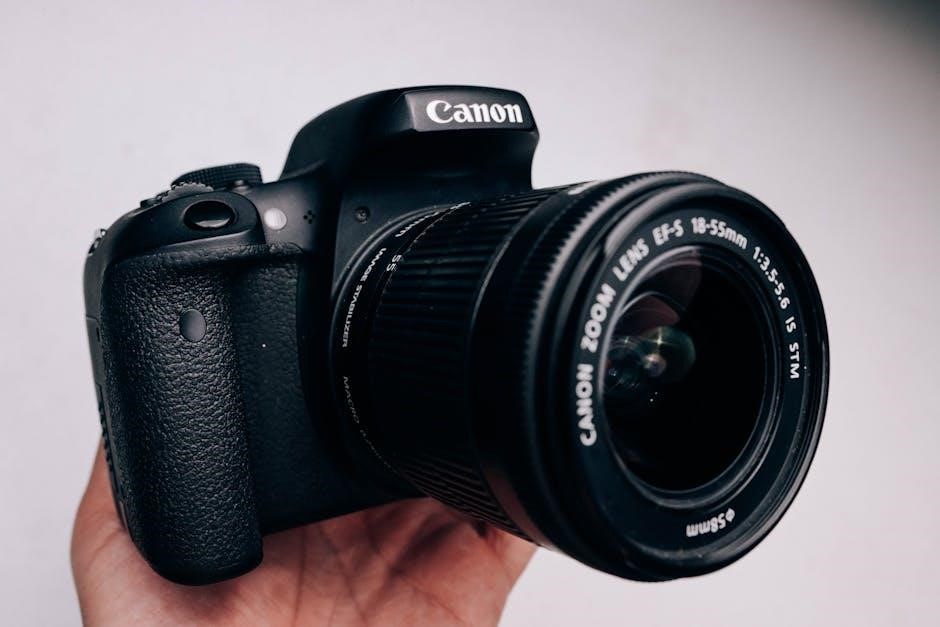Canon EOS R50 Manual: A Comprehensive Guide
Welcome to the definitive guide for your Canon EOS R50! This comprehensive manual will walk you through every aspect of your camera, from initial setup to advanced techniques. Whether you’re a beginner or an experienced photographer, unlock the full potential of your EOS R50 today.
The Canon EOS R50 is a versatile and lightweight mirrorless camera designed for content creators and photography enthusiasts. This APS-C sensor camera boasts impressive image quality and 4K video capabilities, making it an excellent choice for both beginners and experienced users. Its user-friendly interface and comprehensive feature set ensure a smooth learning curve and creative freedom.
This manual provides a detailed overview of the EOS R50’s features, functions, and settings. Whether you’re interested in capturing stunning photos or creating engaging videos, this guide will help you master the camera’s capabilities. From understanding the basic controls to exploring advanced shooting techniques, you’ll find all the information you need to unlock the full potential of your EOS R50. Learn to navigate the menu system, customize settings, and troubleshoot common issues.

With its compact design and intuitive controls, the EOS R50 is perfect for on-the-go shooting. Discover how to connect to Wi-Fi and Bluetooth for seamless sharing and remote control. Dive into the world of creative photography and videography with the Canon EOS R50, your ideal companion for capturing life’s precious moments.
Initial Setup and Basic Operations
Let’s begin your journey with the Canon EOS R50 by covering the essential initial setup and basic operations. First, unpack your camera and ensure all components are present, including the battery, charger, and strap. Charge the battery fully before the first use to maximize its lifespan. Once charged, insert the battery into the camera body and attach your desired lens.
Next, power on the camera and set the language, date, and time. Familiarize yourself with the main controls, such as the power switch, shutter button, and mode dial. The mode dial allows you to select various shooting modes, including Auto, Program, Aperture Priority, Shutter Priority, and Manual. In Auto mode, the camera automatically adjusts settings for optimal results. Experiment with different modes to understand their effects on your images.
Learn how to navigate the camera’s menu system using the directional buttons and set button. Adjust basic settings like image quality, file format, and ISO. Practice taking photos by pressing the shutter button halfway to focus and fully to capture the image. Review your shots on the LCD screen using the playback button. Mastering these basic operations will provide a solid foundation for exploring the EOS R50’s advanced features.
Understanding the Camera’s Menu System
Navigating the Canon EOS R50’s menu system is crucial for customizing your camera and accessing its advanced features. To access the menu, press the “MENU” button located on the camera’s body. The menu is organized into several tabs, each containing related settings. These tabs typically include “Shooting,” “Playback,” “Setup,” “Custom Functions,” and “My Menu.”

Within the “Shooting” tab, you’ll find options for image quality, ISO settings, white balance, and shooting mode. The “Playback” tab allows you to configure how images are displayed and reviewed on the LCD screen. The “Setup” tab contains general camera settings such as language, date/time, and display brightness. “Custom Functions” enable you to personalize the camera’s behavior to suit your shooting style.
The “My Menu” tab is a customizable section where you can add frequently used menu items for quick access. Spend time exploring each tab and its options to understand the available settings. Use the directional buttons to navigate through the menus and the “SET” button to confirm your selections. Don’t hesitate to consult the advanced user guide for detailed explanations of each setting; A thorough understanding of the menu system will empower you to fine-tune your EOS R50 for optimal performance.
Shooting Modes: A Detailed Overview
The Canon EOS R50 offers a variety of shooting modes to cater to different photographic scenarios and skill levels. Understanding these modes is essential for capturing the best possible images. The mode dial, typically located on the top of the camera, allows you to switch between different shooting modes.
Scene Intelligent Auto (A+): This mode is fully automatic, allowing the camera to analyze the scene and select the appropriate settings. It’s ideal for beginners or situations where you need to quickly capture a shot without adjusting settings manually.
Creative Assist: This mode provides an intuitive interface for adjusting image parameters like brightness, contrast, and color tone, allowing you to achieve creative effects without technical knowledge.
SCN (Scene): This mode offers a range of preset scene modes optimized for specific situations, such as portrait, landscape, sports, and night photography.
Hybrid Auto: This mode records a short video clip before each photo you take, creating a highlight reel of your day.
Movie Mode: Dedicated for recording videos, allowing control over resolution, frame rate, and audio settings.
Program AE (P): The camera sets the aperture and shutter speed automatically, but you can adjust other settings like ISO and white balance.
Shutter-priority AE (Tv): You set the shutter speed, and the camera automatically selects the appropriate aperture.
Aperture-priority AE (Av): You set the aperture, and the camera automatically selects the appropriate shutter speed.
Manual (M): You have full control over both aperture and shutter speed.
Experiment with each mode to discover which one best suits your shooting style and the specific conditions you encounter.
Focusing Techniques and Options
Mastering the focusing system of the Canon EOS R50 is crucial for capturing sharp and detailed images. This camera offers a range of focusing techniques and options to suit various shooting scenarios. The autofocus (AF) system is highly advanced, providing fast and accurate focusing in both still and video modes.
Autofocus Modes: The EOS R50 features several AF modes, including One-Shot AF for stationary subjects, Servo AF for moving subjects, and AI Focus AF, which automatically switches between One-Shot and Servo AF based on subject movement.
Focus Areas: You can select different focus areas, such as Single-point AF, Zone AF, and Wide Area AF, to control the area of the frame that the camera uses to focus. Face Detection and Eye Detection AF are also available, allowing the camera to automatically detect and focus on faces and eyes.
Manual Focus: For precise control, you can switch to manual focus (MF) mode and adjust the focus ring on the lens. The camera provides focus peaking and focus magnification to assist with manual focusing.
Focus Peaking: This feature highlights the areas of the image that are in focus, making it easier to achieve sharp focus when using manual focus.
Back-Button Focus: You can customize the camera to use a button on the back of the camera for focusing, separating the focusing function from the shutter button.
Experiment with these focusing techniques and options to find the best settings for your specific shooting needs and achieve consistently sharp results.
Image Playback and Review
The Canon EOS R50 offers a variety of options for image playback and review, allowing you to quickly assess your shots and make necessary adjustments. After capturing images, you can instantly review them on the camera’s LCD screen or through the electronic viewfinder (EVF).

Basic Playback: Press the playback button to view the last captured image. Use the left and right arrow buttons to navigate through your images. The camera displays basic information such as the file number, shooting mode, and exposure settings.
Detailed Information: Pressing the INFO button during playback cycles through different display options, including detailed shooting information, histogram, and highlight alert. The histogram provides a graphical representation of the image’s tonal range, helping you identify potential exposure issues.
Zoom and Crop: You can zoom into images to check focus and detail. Use the control dial to zoom in and out, and the multi-controller to pan around the image. The camera also allows you to crop images directly in playback mode.
Image Rating: Rate your images using the rating feature to easily identify your best shots later. You can assign ratings from one to five stars, making it easier to sort and filter images in post-processing software.
Deleting Images: Delete unwanted images directly from the camera. You can delete single images or multiple images at once. Be cautious when deleting images, as this action is irreversible.
Connecting to Wi-Fi and Bluetooth
The Canon EOS R50 offers seamless connectivity through Wi-Fi and Bluetooth, enabling you to transfer images wirelessly, remotely control the camera, and share your creations with ease. Connecting to Wi-Fi allows you to directly upload images to cloud services or share them on social media platforms.
Wi-Fi Setup: Access the camera’s menu and navigate to the wireless communication settings. Select the Wi-Fi option and choose your preferred connection method, such as connecting to a Wi-Fi network or creating an ad-hoc network. Enter the network password if required.
Bluetooth Pairing: Enable Bluetooth on your smartphone or tablet and put the camera in pairing mode. The camera will appear in the list of available devices on your mobile device. Select the camera and follow the on-screen instructions to complete the pairing process.
Canon Camera Connect App: Download and install the Canon Camera Connect app on your smartphone or tablet. This app allows you to remotely control the camera, transfer images, and geotag your photos using your mobile device’s GPS.
Remote Control: Use the Canon Camera Connect app to remotely control the camera’s shutter, aperture, ISO, and other settings. This feature is particularly useful for self-portraits, group photos, and long-exposure photography.
Image Transfer: Transfer images wirelessly from the camera to your smartphone or tablet. You can choose to transfer individual images or batch transfer multiple images at once.
Troubleshooting Common Issues
Even with a user-friendly camera like the Canon EOS R50, you might encounter some common issues. This section provides solutions to frequently faced problems, ensuring a smooth shooting experience. Before assuming a malfunction, carefully review these troubleshooting steps.

Camera Won’t Turn On: Ensure the battery is properly inserted and fully charged. Check the battery contacts for dirt or debris. If the issue persists, try a different battery.
Image is Blurry: Verify that the lens is clean and properly attached. Check your focus settings and ensure the subject is within the focusing range. Increase the shutter speed to avoid motion blur.
Error Messages: Note the error code displayed on the screen. Consult the manual for specific error code explanations and recommended solutions. A common error is related to memory card issues.
Memory Card Problems: Ensure the memory card is compatible and properly inserted. Try formatting the card in the camera. If the card is corrupted, you may need to replace it.
Wi-Fi Connectivity Issues: Double-check your Wi-Fi password and network settings. Ensure the camera is within range of the Wi-Fi router. Restart both the camera and the router.
Image Transfer Problems: Verify the USB cable is securely connected. Check the computer’s device manager for driver issues. Try a different USB port or cable.
Advanced Features and Custom Settings
The Canon EOS R50 offers a range of advanced features and custom settings that allow you to fine-tune your photography experience. This section delves into these options, enabling you to tailor the camera to your specific needs and creative vision. By exploring these settings, you can unlock the full potential of the EOS R50.
Custom Functions (C.Fn): Access a variety of custom functions to personalize button assignments, dial operations, and other camera behaviors. Experiment with these settings to create a workflow that suits your shooting style.
Picture Styles: Explore different picture styles to adjust the color, contrast, and sharpness of your images. You can also create and save your own custom picture styles for consistent results.
Creative Filters: Apply creative filters such as Grainy B/W, Soft Focus, and Fish-eye Effect to add artistic flair to your photos directly in-camera.
HDR Mode: Capture high dynamic range images by combining multiple exposures to reveal details in both highlights and shadows, perfect for landscapes and high-contrast scenes.
Interval Timer: Use the interval timer to automatically take a series of photos over a set period, ideal for creating time-lapse videos.
Custom White Balance: Achieve accurate colors in challenging lighting conditions by setting a custom white balance based on a reference object.
Firmware Updates and Software Downloads
Keeping your Canon EOS R50’s firmware up-to-date is crucial for optimal performance and access to the latest features. Canon regularly releases firmware updates to address bugs, improve functionality, and introduce new capabilities to your camera. This section guides you through the process of checking for and installing firmware updates.
Checking Firmware Version: Learn how to access the camera’s menu to identify the current firmware version installed on your EOS R50. This information is essential for determining if an update is available.
Downloading Firmware Updates: Visit the official Canon website to download the latest firmware update for your EOS R50. Ensure you download the correct version for your region and camera model.
Installation Process: Follow the step-by-step instructions provided by Canon to install the firmware update on your camera. This typically involves copying the firmware file to an SD card and updating the camera through its menu system.
Software Downloads: Explore the range of software available for your EOS R50, including Canon’s Digital Photo Professional (DPP) for image editing, EOS Utility for camera control and image transfer, and Picture Style Editor for creating custom picture styles. Download these tools from the Canon website to enhance your workflow.
Accessing the Advanced User Guide (PDF)
The Canon EOS R50 is a powerful camera with a multitude of features, and to fully harness its capabilities, consulting the Advanced User Guide is essential. This comprehensive PDF document provides in-depth explanations of every function, setting, and menu option available on your camera. This section details how to access and utilize this valuable resource.
Finding the Download Link: The Advanced User Guide is readily available for download from the official Canon website. Navigate to the support section for the EOS R50 and locate the link for the PDF manual. You can also find it by scanning the QR code displayed on the camera’s screen via the menu.
Navigating the PDF: The PDF is structured for easy navigation, with a detailed table of contents and a comprehensive index. Use these tools to quickly find the information you need.
Searching for Specific Topics: Utilize the PDF reader’s search function to locate specific keywords or topics within the manual. This is a fast and efficient way to find answers to your questions.
Using the Guide Offline: Download the PDF to your computer, tablet, or smartphone for offline access. This allows you to consult the manual anytime, anywhere, even without an internet connection.
